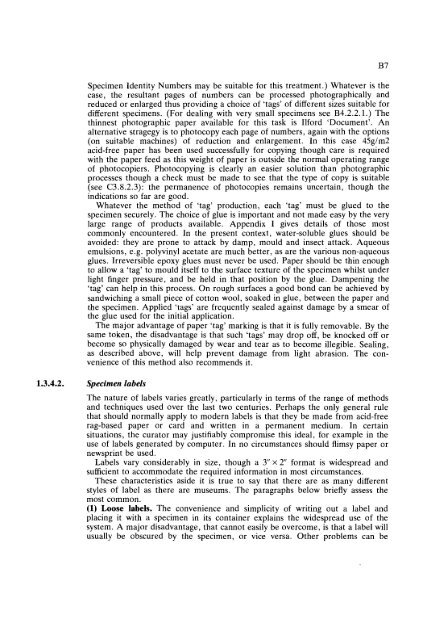GUIDELINES FOR THE CURATION OF GEOLOGICAL MATERIALS
GUIDELINES FOR THE CURATION OF GEOLOGICAL MATERIALS
GUIDELINES FOR THE CURATION OF GEOLOGICAL MATERIALS
Create successful ePaper yourself
Turn your PDF publications into a flip-book with our unique Google optimized e-Paper software.
Specimen Identity Numbers may be suitable for this treatment.) Whatever is the<br />
case, the resultant pages of numbers can be processed photographically and<br />
reduced or enlarged thus providing a choice of 'tags' of different sizes suitable for<br />
different specimens. (For dealing with very small specimens see B4.2.2.1.) The<br />
thinnest photographic paper available for this task is Ilford 'Document'. An<br />
alternative stragegy is to photocopy each page of numbers, again with the options<br />
(on suitable machines) of reduction and enlargement. In this case 45glm2<br />
acid-free paper has been used successfully for copying though care is required<br />
with the paper feed as this weight of paper is outside the normal operating range<br />
of photocopiers. Photocopying is clearly an easier solution than photographic<br />
processes though a check must be made to see that the type of copy is suitable<br />
(see C3.8.2.3): the permanence of photocopies remains uncertain, though the<br />
indications so far are good.<br />
Whatever the method of 'tag' production, each 'tag' must be glued to the<br />
specimen securely. The choice of glue is important and not made easy by the very<br />
large range of products available. Appendix I gives details of those most<br />
commonly encountered. In the present context, water-soluble glues should be<br />
avoided: they are prone to attack by damp, mould and insect attack. Aqueous<br />
emulsions, e.g. polyvinyl acetate are much better, as are the various non-aqueous<br />
glues. Irreversible epoxy glues must never be used. Paper should be thin enough<br />
to allow a 'tag' to mould itself to the surface texture of the specimen whilst under<br />
light finger pressure, and be held in that position by the glue. Dampening the<br />
'tag' can help in this process. On rough surfaces a good bond can be achieved by<br />
sandwiching a small piece of cotton wool, soaked in glue, between the paper and<br />
the specimen. Applied 'tags' are frequently sealed against damage by a smear of<br />
the glue used for the initial application.<br />
The major advantage of paper 'tag' marking is that it is fully removable. By the<br />
same to~en, the disadvantage is that such 'tags' may drop off, be knocked off or<br />
become so physically damaged by wear and tear as to become illegible. Sealing,<br />
as described above, will help prevent damage from light abrasion. The convenience<br />
of this method also recommends it.<br />
1.3.4.2. Specimen labels<br />
The nature of labels varies greatly, particularly in terms of the range of methods<br />
and techniques used over the last two centuries. Perhaps the only general rule<br />
that should normally apply to modern labels is that they be made from acid-free<br />
rag-based paper or card and written in a permanent medium. In certain<br />
situations, the curator may justifiably compromise this ideal, for example in the<br />
use of labels generated by computer. In no circumstances should flimsy paper or<br />
newsprint be used.<br />
Labels vary considerably in size, though a 3" X 2 format is widespread and<br />
sufficient to accommodate the required information in most circumstances.<br />
These characteristics aside it is true to say that there are as many different<br />
styles of label as there are museums. The paragraphs below briefly assess the<br />
most common.<br />
(1) Loose labels. The convenience and simplicity of writing out a label and<br />
placing it with a specimen in its container explains the widespread use of the<br />
system. A major disadvantage, that cannot easily be overcome, is that a label will<br />
usually be obscured by the specimen, or vice versa. Other problems can be

















